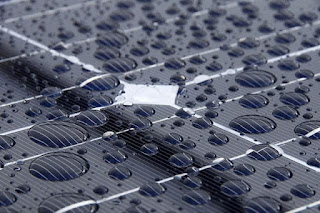 |
| Now, Solar cells that can work in the rain. Image credit: majesticearth.co.au |
In case you have read my last
month’s guest post about harvesting
solar energy in rust, you would be delighted to know that there has been
yet another breakthrough in our attempt to harness solar energy. For many years, solar energy has been targeted
for being unavailable at night and during rains. The problem of utilizing solar
energy at night can be resolved with the help of metal oxide cells as
elaborated in my above post (do read it, if you have not done so already). And
now researchers at the Ocean University in China have addressed the second
problem and developed solar cells that can actually use rain drops to generate
electricity.
Chemie, the paper titled, A
Solar Cell Triggered by Sun and Rain, opens a new realm of possibilities
when harnessing solar energy. Coating the solar cell with a thin film of graphene
allows the cell to function even when it is raining. Graphene is nothing but reduced
form of graphite that consists of a honeycomb arrangement of carbon atoms in a
two dimensional matrix. Although known to us for over 50 years, graphene was
rarely studied until recently in 2004, where it was studied in greater depth
and its abundant properties were brought to the fore. A good conductor of heat
and electricity, it is almost transparent and yet stronger than steel. Showing
bipolar transistor effect, graphene has also found its way into modern
electronics such as computers, smartphones, TVs etc. and is making strides in
biological research to be used as a biosensor for detecting cancers and also as
electrode to engage with neurons.
 |
| Rain drop creating a difference in potential when it impacts the graphene layer, thus acting as a pseudocapacitor. Image credit: www.wiley-vch.de |
researchers used graphene’s property of binding to positively charged ions to
generate minute amounts of electricity from their modified solar cell. Raindrops
carry some impurities with them as they descend from the sky. These impurities
are usually in the form of certain salts that are made up of common elements
such as sodium, calcium, ammonium etc. When dissolved in water, these salts
dissociate into their respective ions and upon impact with a solar cell
containing a thin graphene layer, form a pseudocapacitor, that has positively
charged ions of water on side and the negatively charged electrons of graphene
on the other, creating a potential difference (in microvolts) that is
sufficient to generate electric current and hence electricity.
researchers are still in their early phases but have managed to convert 6.53%
of solar energy into electricity. Although this might not sound like a lot,
considering the fact that rain drops were deterrent to working of a solar cell,
this is huge accomplishment and paves way for further work to be done to
increase the effectiveness of solar cells. As mentioned in our previous
post about solar cells, currently solar cells are able to convert 10-15% of
solar energy into electric energy and a simple layering of graphene on them
should enable boosting of this capacity.
at University of Surrey were also able to use graphene to utilise the diffused
sunlight that we get inside our homes and never utilise. Coating walls with
graphene films could also help us harness more solar energy than we ever have.
References:
Tang, Q., Wang, X., Yang, P., & He, B. (2016). A Solar Cell That Is Triggered by Sun and Rain Angewandte Chemie DOI: 10.1002/ange.201602114
Anguita JV, Ahmad M, Haq S, Allam J, & Silva SR (2016). Ultra-broadband light trapping using nanotextured decoupled graphene multilayers. Science advances, 2 (2) PMID: 26933686




2 comments
New solar technologies are emerging every day, so it is impossible to tell what the sun might be used to power next. It is safe to say that there is no end to the possibilities.best solar motion security lights
Thanks this is awesome. I hope that the solar cells with the help of graphene work better in the rain. It could be a revolution in the terms of nanotechnology and ecological energy production. I hope that it works out.